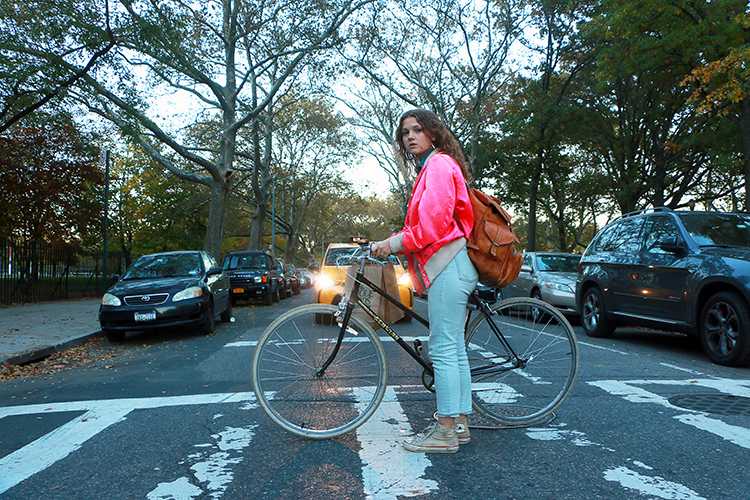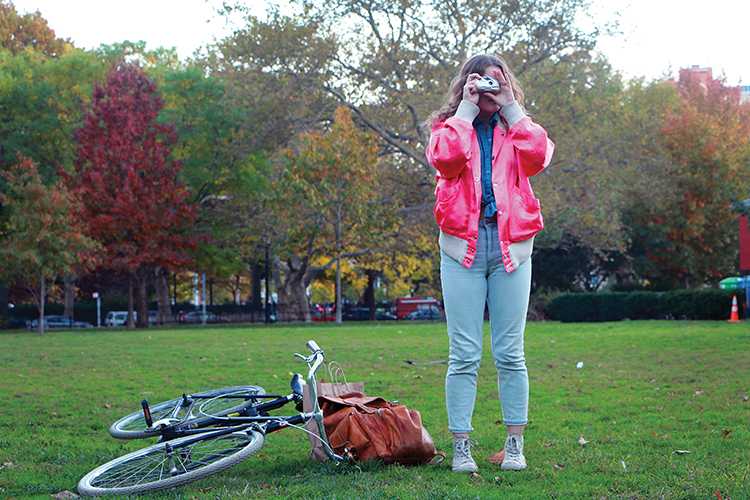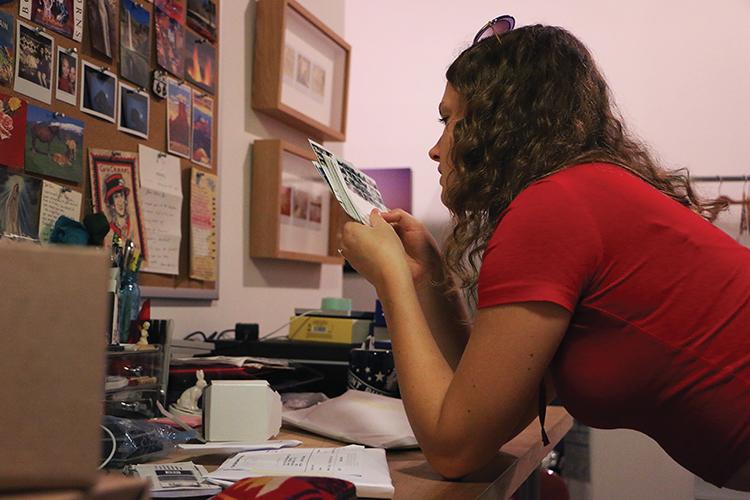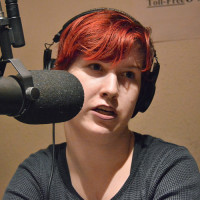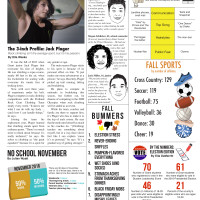This isn’t your typical photo shoot.
Surrounded by an animal handler, documentary filmmakers and her assistant, Grant High School graduate Olivia Bee stands naked in a patch of woods at Trillium Lake, the late afternoon sun filtering through the trees.
On this day, the world famous photographer is doubling as a model. Cradling a husky-wolf hybrid, she stares into her camera that’s perched atop a tripod as the shutter clicks, snapping photos.
“I think it helps you feel really human … to be like naked with a wolf,” says Bee.
Bee is taking a break from her commercial gigs to shoot something that hits a little closer to home. Her goal is to use art to capture her relationship with a family member who passed away before Bee was born.
“It’s important to me that I make pictures about my inner emotional experience,” she says.
After the filming wraps up that evening, Bee thinks ahead to her next steps: developing the film and writing the poems that will accompany the photos, all part of what will make the project complete.
For Bee, creativity isn’t just a passion. It’s part of her core and has been for some time. Photography has been her main outlet since she was a student at daVinci Arts Middle School. “This is why I exist,” says Bee of her work.
Now 22, the woman who graduated from Grant in 2012 and travels the globe to pursue her craft, is proof that artists can make it in the real world, even at an early age. Bee, who’s quick to laugh and make a joke but who can also command a room within seconds, got her professional start in the industry while still in high school. She’s walked a fine line as a young person in an adult-dominated profession.
“People like to question young talent. People don’t think that young people can do well,” says Bee. “When I was younger … people thought that it was like my dad or like an older 40-year-old man who was running my Flickr and taking pictures of his daughter, and it’s like no one can fake this perspective.”
She did a shoot with Converse, the shoe company, when she was 15. That was followed by photo shoots with The New York Times Magazine, Fiat and Hermès, among others. Notoriety followed as people took notice. Now, Bee is nothing short of a success.
“The main thing with her is that she continues to be sought after,” says Molly Ortiz, a film and photography producer who has worked with Bee. People “are interested in what Olivia as an artist wants to do.”
But for Bee, photography and film has always been far more than a job. It’s how she makes sense of the world. “I have to do it,” says Bee. “I have to. It’s my common link through all of my experiences, and it’s like how I survive and how I process my emotions and actions and things that are happening to me.”
Even with all the work – she has more than 50 editorial and commercial clients – Bee always makes time for personal projects such as the one at Trillium Lake.
Her style isn’t the typical commercial approach. Many of her photos center on the theme of love and are dream-like in a sense: tinted with pinks and purples and blurry or overexposed, often times depicting friends barely clothed embracing in a field or herself staring into the camera wearing a floaty dress.
“I’m just showing honest magic, like it’s shit I see, with like rose-colored glasses for sure. But it’s honest underneath it,” Bee says of her approach. “I just see it in a romantic way.”
[aesop_gallery id=”18260″]
As a young woman, Bee is an anomaly in an industry that’s dominated by older men. A State of News Photography study in 2015 found that only 7 percent of women were likely to be hired by a major media company, compared to 22 percent of men. And in the film industry, there’s a 5-to-1 ratio of men versus women behind the camera.
It’s something Bee’s had to navigate throughout her career, and it’s rare that she steps onto a shoot without hearing a remark about her age or her youthful appearance. By now, though, Bee knows how to dodge such comments and approaches her work with an unflinching confidence.
“I think telling your stories gives them power, and when you photograph something it’s as much a picture of your subject as it is you,” she says. “Like you’re literally showing what you desire and what you love and how you see the world … Your medium is reality.”
Bee was born Olivia Bolles in Southeast Portland on April 5, 1994, to her parents, Cara and Houston Bolles. Her brother, Max Bolles, came along five years later. Art is part of the family’s fabric; her mother has loved photography since high school, and she sews and knits whenever she can. Her grandfather was an illustrator.
Bee’s parents made an effort to encourage their children to be independent. “We pretty much just set (Olivia) loose,” recalls Houston Bolles.
And they can’t remember a time when their daughter wasn’t making art. At 2, she started coloring, drawing and painting. Her first art studio was a tiny room underneath the staircase, where Bee covered the walls in paint and drawings.
She didn’t play soccer or take music lessons, unlike most of the kids her age. Instead, she took weekly classes at Pacific Northwest College of Art, where she delved into sculpture. For one of her projects, Bee made a llama, using a fork to texture cones of clay that she stuck across the body to look like real fur.
Her family also still has a giraffe and monkey duo in the living room that was painted blue with clouds and grass by Bee. “She was always really pushing the boundaries in what was possible in terms of art,” remembers Cara Bolles.
Bee wanted to attend daVinci Arts Middle School in Northeast Portland, the only middle school in the Portland Public Schools District with a strong focus on the arts. The school uses a lottery system to admit students, and Bee was the last student to get in in 2005.
She has explained how she got into photography in middle school countless times. She signed up for a video production class, but she was switched to darkroom photography and was less than thrilled.
“I hated it,” she says. “I didn’t know how to use the chemicals, and I felt like what I saw in my head was very different than what I was able to make happen in a picture.”
She worked at it, shooting her stuffed animals, Christmas ornaments and other objects around her house – “stupid shit,” she says now. She continued to work in the darkroom at daVinci to develop her photos.
By seventh grade, Bee started posting her photos on Flickr, a photo sharing website. Her parents worried about the safety of using her real name online, and they suggested she change her last name for Flickr. She took the initial of her last name and made it into a word. “I think it’s kind of like stuck at this point,” says Bee now.
She began taking photos of her friends and family, developing her film in the daVinci darkroom. Max Bolles remembers his sister coming into his room and taking photos of him. She’d have him pose in different parts of their house, in a burned-down building or in a nearby park. “I just kinda got used to it at a certain point,” he says. “It was just like the normal thing.”
When Bee started at Grant, her Flickr account had gained a sizable following, and she described herself then as “the artsy girl.” She only went to one football game and rarely attended school dances, instead spending much of her time in the class darkroom with her friends. She took photography from sophomore through senior year.
“I think telling your stories gives them power, and when you photograph something it’s as much a picture of your subject as it is you. Like you’re literally showing what you desire and what you love and how you see the world … Your medium is reality.”- Olivia Bee
Her passion didn’t stop her from wanting to be a typical teenager in high school. “I wanted to go to parties. I wanted to have boyfriends. I wanted to do stupid things,” she recalls. “Get in trouble with the police, party, get a car, go to a high school football game, go to Greek Fest, wear mittens with my high school name on it, do my homework, carry around a textbook.”
Her friend, Tuesday Faust, who went to Grant and is a year younger than Bee, remembers how she wore flared pants and bedazzled jean jackets. “She was the queen of the cool, really good artists and they all were like hilarious and dressed really well,” Faust recalls.
Bee got her first shot at the big time when she was 15. Representatives at Converse sent her an email because they were intrigued by her work. “I thought it was fake, and so I didn’t respond,” she remembers. “And then they sent me another email, and I still thought it was fake and didn’t respond.”
It wasn’t until Bee received yet another email that she realized it was real. A Converse official wanted to know if she would consider doing a Portland photo shoot.
While at the shoot in a Northeast Portland home, she shot secondary photographs while more experienced Los Angeles photographers clicked away. Her dad checked in with her periodically. Afterwards, she sat down with a DigiTech, a person who helps edit photographs.
“I just watched her tell him what the colors needed to be and … what palette to choose,” recalls Houston Bolles. “She shot everything, and she knew exactly how she wanted it to look. The pink and the purples and the over-saturated stuff that she’s known for, she was doing that from the very beginning.”
A few months later, she participated in a Nike shoot, which was when her parents booked her an agent. She later flew to Paris for a Converse show and shot a commercial for Fiat.
With so many new opportunities, Bee often had to step out of her school classrooms for work.
She remembers being in an art class once when she had to participate in a conference call with Time Magazine. When her teacher told her she couldn’t leave, she did the call under the table. “I’m sure I sounded super unprofessional,” Bee remembers. “Then I learned you don’t ask, you just leave.”
During her sophomore year, a project caused her to miss a significant chunk of school. Her pre-calculus teacher at the time wasn’t happy. Bee hadn’t done the homework assigned from when she was gone. “She was just yelling at me, ‘You think you can just take pictures for Nike and do that for the rest of your life?’” Bee recalls.
Her parents tried to work with teachers so Bee could be excused from school. Sometimes, it took some extra convincing. “I remember the question was: ‘Well, is your daughter a student or is she a professional photographer?” Houston Bolles says now.
Cara Bolles remembers thinking perhaps her daughter would’ve been treated differently if she were an athlete. “Kids get out of school early on a twice weekly basis to go to a game,” she says. “They get out of school to go to state championships … It’s a double standard.”
Cristy McCarty, Bee’s photography teacher at Grant, remembers watching her student go through the process from the sidelines. “I feel like there’s this thing of like, ‘Oh it’s art,’” she says.
At 17, Bee was asked to shoot the cover of The New York Times Magazine for a story called, “Teaching Good Sex.” Bee shot her friends running and holding hands for the photos that appeared in the spread.
Bee then spent the summer between her junior and senior year in The Netherlands, Spain and England, working for a company called &Samhoud.
As high school came to an end, Bee shifted her attention to her work – “I kind of trailed off senior year,” she says.
That’s when she realized traditional school wasn’t for her. It wasn’t for her brother either, who dropped out of Franklin High School in the spring of his sophomore year.
“School needs to be revamped big time,” Bee says now. “Some people would rather travel and learn a language instead of sitting in a classroom all day. We’re trying to put people in the same spot when people are really, really different. That’s really troubling.”
Her senior year, Bee chose just one college to apply to: Cooper Union, a renowned art school in New York. For part of her application, she photographed about 20 friends painted head to toe in blue at the top of Mt. Tabor Park.
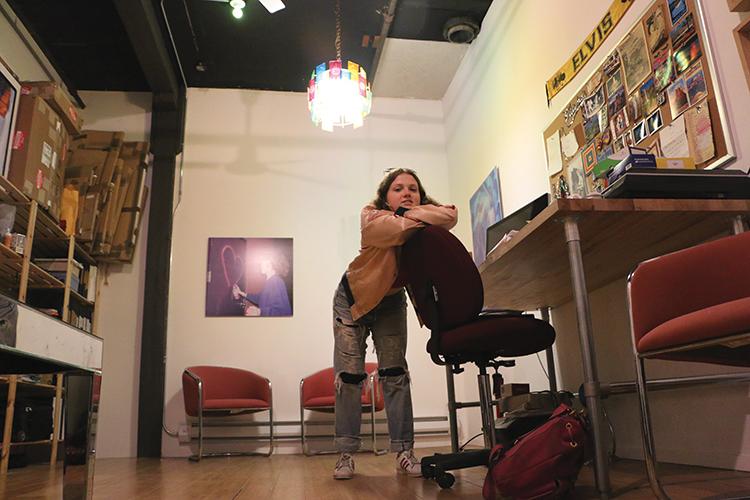
Her friend, Faust, was painted pink and held an ice cream cone, as everyone else held a hamburger. The prompt was a word: aberrance, or “straying from the norm.” She didn’t get accepted. In hindsight, Bee says now, “It wouldn’t have been the right place for me.”
Instead, Bee moved to Baltimore with her boyfriend, who was starting school there. Things didn’t work out as she had hoped. She acknowledges that she was depressed and felt unsafe in the city. “I definitely lost myself a bit there,” she says.
Only a few months later, Bee packed up and moved again, this time to New York City. “If you wanna do photo and art and stuff, then go to New York,” she says. It was a big move to make on her own, but her parents weren’t too worried.
“I think actually it’s a pretty safe place to be because of the sheer number of people,” says Cara Bolles.
After some searching, she found an apartment, and jobs began trickling in. Things were still slow, and Bee had to live off mostly beans for a little while.
In 2013, Bee traveled to Athens for a conference centered on innovation and creativity. She gave a Ted Talk at the conference about her budding career.
“People put a lot of pressure on me because I have young success,” she said during the talk. “It has the potential to overshadow the rest of my career. People sometimes look at my age more than my photographs. But what I’m most proud of is my actual photographs and how happy it makes me to make them.”
In 2014, Bee shot a fall coats collection for Vogue and spreads for a handful of indie European magazines. She shot an album cover for English singer Birdy in 2015 and later shot Birdy again for a RedxValentino campaign in Great Britain.
Sexism in the industry has only become more apparent for Bee. She can recall one time in another country when, after 17 hours of shooting, a male director refused to give her a break or time to eat. After she persisted, he finally handed her a bowl of jelly, exasperated, adding: “Maybe this will make you into a man.”
And sometimes, she says, people assume she’s the assistant rather than the photographer. She remembers someone handing her a walkie-talkie when she walked onto the set. “I’m like, ‘No, I’m taking the picture. I’m making all of this happen. You’re here because I’m here, actually,’” says Bee.
That sort of thing used to chip away at Bee’s confidence, causing her to shut down and not speak out. In some cases, that meant not getting the shot she needed for fear of making others uncomfortable.
Now, though, she makes no apologies and simply gets the job done on her terms.
“I’m not gonna waste my energy on convincing people that I deserve to be there other than the fact that I’m going to be myself,” Bee says. “I’m gonna be professional, and I am gonna get the job done.”
Michael Beckert was Bee’s first intern. He says his former boss, who he considers both a friend and a mentor, tends to be upfront when it comes to photo shoots and won’t back down. “If someone’s trying to demean her, she doesn’t really let it get in her way,” Beckert says. “She’s very polite, but she also knows that she’s the boss.”
Sometimes, Bee’s schedule takes a toll. Last spring, she remembers leaving her phone, her camera and her keys all in different states throughout a frenzy of photo shoots. “I was just like on the bottom of my energy,” she says. “I hope it’s not as crazy as it was again, but I’m sure it will be.”
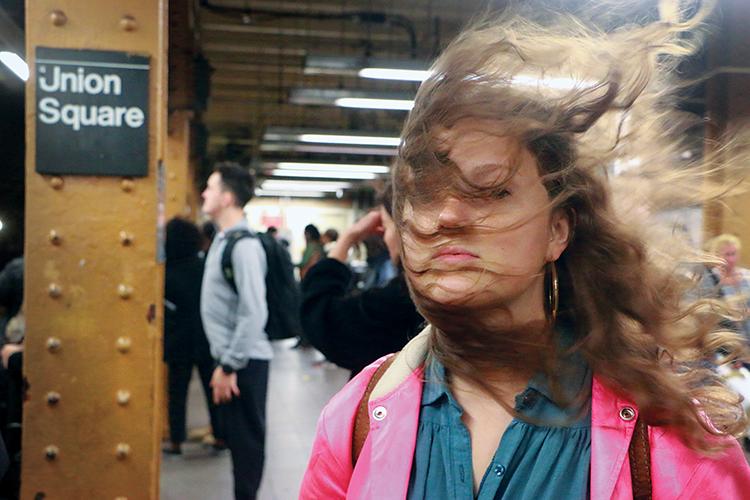
After that, Bee slowed things down. Now, she splits her time between New York and Los Angeles, and the constant travel can make it a challenge to find the balance between work and rest. When she does have time off, she likes to write in her journal, work out and catch up with friends.
Last March, Bee published a book of photos, called “Kids in Love.” The cover is light purple with a rainbow, and it depicts her time in high school and more recent moments. “I was just shooting pictures of my life and what was going on around me, and then once it was done, I realized, ‘Oh, it’s a book,’” says Bee.
More recently, Bee shot a series of photos for Teen Vogue. It was for a story that centered around young people in LGBTQ+ relationships. “That was really special to photograph all these people who have beautiful relationships that aren’t hetero-normative and put them on a huge platform like Teen Vogue,” she says.
Bee hasn’t slowed down on her personal projects. Recently, she and Molly Ortiz took a road trip to Montana to shoot a project that was just for her. Now, she’s looking ahead to transforming her style by venturing more into film.
As for what else is on her bucket list? Photographing Drake and Rihanna and doing a photoshoot in space.
Says Bee: “I think there’s something really interesting about being human in the place that isn’t human at all.” ◆


